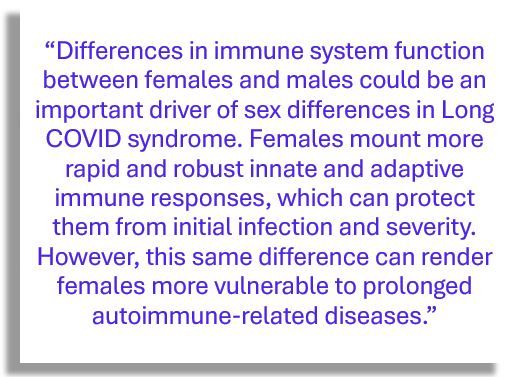Women Found "Significantly" More Likely to Experience Long COVID, Disaggregated Research is Essential, Investigators Say
A literature review comprising ~1.3 million patients infected with SARS-CoV-2 reveals women are 22% more likely vs men to develop long COVID, yet treatment is no different.
©Maria/adobe stock

Women were found “significantly” more likely to experience long COVID than men, with odds of developing the syndrome 22% higher and the type of symptoms substantially different between the sexes, according to a new literature review published June 21, 2022, in Current Medical Research and Opinion.
Investigators from the Johnson & Johnson Office of the Chief Medical Officer Health of Women Team, after analyzing data from approximately 1.3 million patients, found that women with long COVID presented with a range of symptoms including ear, nose, and throat issues; mood, neurologic, skin, gastrointestinal, and rheumatologic disorders; and fatigue.
Men, on the other hand, were more likely to experience endocrine disorders, including diabetes and acute kidney injury (AKI).
Their findings, the authors emphasize, highlight a critical need for sex-disaggregated research to ensure that therapies as well as public health interventions “are inclusive of and sensitive to the potential differential treatment needs of both sexes.”
“Sex differences in outcomes have been reported during previous coronavirus outbreaks,” the authors add. “Therefore, differences in outcomes between females and males infected with SARS-CoV-2 could have been anticipated. Unfortunately, most studies did not evaluate or report granular data by sex, which limited sex-specific clinical insights that may be impacting treatment.”
"Unfortunately, most studies did not evaluate or report granular data by sex, which limited sex-specific clinical insights that may be impacting treatment.”
Focused on this goal themselves, the researchers conducted a literature review, searching 4 large databases to identify COVID-19 studies of adults aged ≥18 years who had tested positive for SARS-CoV-2. The J&J team considered published observational, case-control, cohort, randomized controlled, and retrospective and prospective real-world experience studies of COVID-19 infection that included at least 20 participants and reported complete data by sex.
Time frame for the searches were December 2019–August 2020 for COVID-19 and January 2020–June 2021 for Long COVID syndrome.
Endpoints of interest
The specific endpoints of interest included sequelae of COVID-19 (defined as COVID-related new condition or chronic symptom a patient developed after resolution of acute infection (no longer than 4 weeks from symptom onset) and long COVID syndrome (defined by the persistence of symptoms, development of sequelae, and delayed or long-term complications beyond 4 weeks from the onset of COVID-19 symptoms.
The investigators initially identified 4346 publications of which 23 and 12 met eligibility criteria for COVID-19 and long COVID, respectively. These 35 papers met all eligibility criteria and reported sex-disaggregated data. The final total sample size numbered 1 393 355.
Women signficantly more vulnerable
Sex differences in COVID-19 sequelae <4 weeks after symptom onset
The J&J team found women were significantly more likely than men to experience symptoms in these categories:
Psychiatric and mood (ie, depression) (OR = 1.80; 95% CI: 1.35–2.41)
Ear, nose, or throat (ENT; OR = 1.42; 95% CI: 1.39–1.46)
Musculoskeletal (ie, myalgia) (OR = 1.15; 95% CI: 1.14–1.16)
Respiratory (OR = 1.09; 95% CI: 1.08–1.11)
Men, they found, were significantly more likely than women to be affected by renal disorders (ie, AKI) (OR = 0.83; 95% CI: 0.75–0.93).
While women were more likely to experience cardiovascular symptoms and men to have gastrointestinal and hematologic sequelae (ie, thrombocytopenia) the between-sex differences were not significant, the authors report. They found the likelihood of neurologic symptoms was similar between men and women.
Sex differences in long COVID-19 syndrome (>4 weeks after symptom onset)
Symptoms in these clinical categories reported for long COVID were significantly more likely among women:
ENT (OR = 2.28; 95% CI: 1.94–2.67)
GI (OR = 1.60; 95% CI: 1.04–2.44)
Psychiatric and mood (OR = 1.58; 95% CI: 1.37–1.82)
Neurologic (OR = 1.30; 95% CI: 1.03–1.63)
Dermatologic (OR = 1.29; 95% CI: 1.05–1.58)
Other (OR = 1.36; 95% CI: 1.25–1.49)
Greater likelihood in the “other” category, the study authors note, was driven primarily by differences in rheumatologic disorders (OR = 3.31; 95% CI: 1.27–8.65) and fatigue (OR = 2.34; 95% CI: 1.83–2.98)

Complications more likely to be seen in men fell into the same categories as those for acute symptoms of infection, ie, endocrine disorders (OR = 0.75; 95% CI: 0.69–0.81) and renal disorders (OR = 0.74; 95% CI: 0.64–0.86).
The odds of hemorrhagic, respiratory, and CV complications of long COVID were similar between the sexes.
They conclude: "Devising basic research and clinical trial protocols using sex-specific methodologies, with a primary objective of prospectively evaluating aspects of COVID-19 by sex, will fill critical information gaps. A thorough understanding of how biological sex is influencing COVID-19 will have important implications for clinical management and mitigation strategies for this disease” and offer “the potential to reshape the natural history of COVID-19.”
Reference: Sylvester SV, Rusu R, Chan B, et al. Sex differences in sequelae from COVID-19 infection and in long COVID syndrome: a review. Curr Med Res Opin. 2022. DOI: 10.1080/03007995.2022.2081454